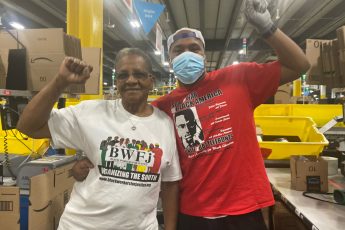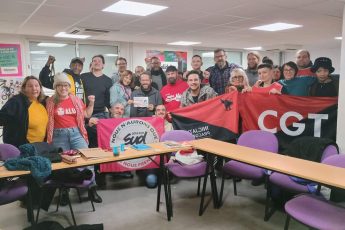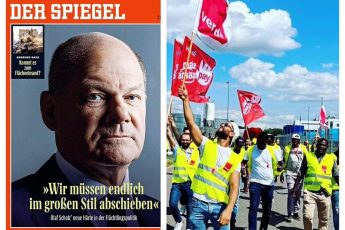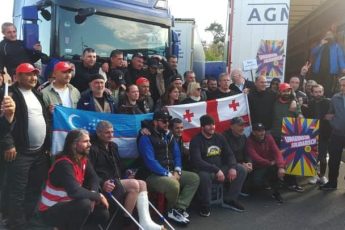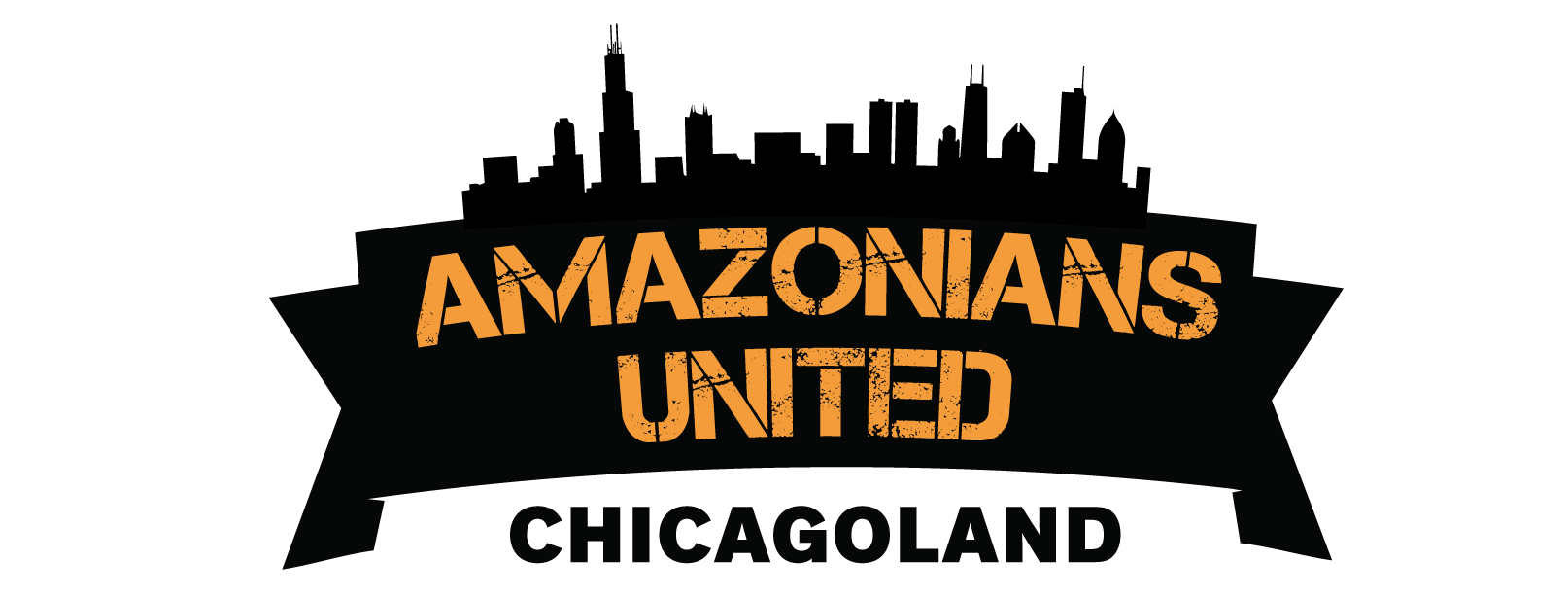
INTERVIEW WITH ZAMA, Amazonians United Chicagoland, Chicago, US
We publish an interview with Zama, a worker in the Amazon DCH1 warehouse in Chicago, member of both Amazonians United Chicagoland and Amazon Workers International. The DCH1 warehouse has been one of the most active in the struggles of the last year and, perhaps also for this reason, will be closed in the coming weeks. Amazon will guarantee the transfer to one of the new warehouses only to employees who will accept the “megacycle shift”, a night shift of more than ten hours (from 1.20 am to 11.50 am) that the company is introducing in all U.S. delivery stations, to allow for customers’ orders to be immediately processed up until midnight. Zama describes the impact that the “megacycle shift” will have on the life rhythms of workers in general, but particularly of women, who are forced into a double burden of exploitation in domestic and reproductive labor, and who would have to face an impossible alternative between a family crisis and an economic crisis. This attempt by Amazon is part of a broader tendency of logistics companies to take advantage of the pandemic by blackmailing workers, especially women and migrants in order to change shifts to their advantage and to lengthen the working day. At the same time, Zama shows how Amazon exploits the racial hierarchies upon which U.S. society is grounded, systematically translating them into wage and power hierarchies within its warehouses, where the workforce is predominantly Black and Latinx. In this respect, the Black Lives Matter protests, which in June set the U.S. ablaze by exposing the racism of institutions and by threatening white supremacy, strengthened the process of struggle that, since the beginning of the pandemic, has led to the emergence of an organization of workers against Amazon in many U.S. cities, recently landing in the Deep South, in Alabama, with the first ballot for unionization of an Amazon warehouse in U.S. history, in a form of which Zama highlights some limits and contradictions.
TSS: Can you tell us what’s happening at the Amazon Delivery Station (DCH1) where you work in Chicago? What is the “megacycle shift” that Amazon wants to impose? How will this affect workers in general and women in particular?
Zama: Amazon is closing the DCH1 Delivery Station in Chicago. HR announced on January 25 that the final day of operation will be April 2nd, and that we are guaranteed a transfer to one of the three new sites they built. Before this announcement, they had already forcefully transferred all of the white badges (seasonal workers) to those new sites, promising them they would get converted to blue badges (permanent workers). Workers at DCH1 currently work the 8.15pm – 4.45am shift or a 4-5 hours shift during the day. These new sites operate on Amazon’s new megacycle shift, from 1.20 am to 11.50 am. Working these hours four days a week will hurt my ability to sleep and to socialize. But for mothers especially, this shift change will make life extremely difficult. Amazon is making them choose between entering a financial crisis or a family crisis.
And there are safety and transportation issues too. Workers live in rough neighborhoods, Amazon’s new Delivery Stations are in rough neighborhoods, and public transportation at the middle of the night in Chicago is unsafe and in some cases impossible. If workers cannot work the megacycle shift, they will be terminated on April 2.
Amazon’s conversion of Delivery Stations to the megacycle is a national process change which began in 2020. We were told that the megacycle was created to give customers until midnight for their orders to be processed. The megacycle combines the work of two shifts, Sortation (8 hours) and Loadout (4 hours), into one. The megacycle is 10 hours. This is a radical change because before the megacycle was introduced, all Delivery Station workers were part-time. Now, Amazon is standardizing the megacycle across the United States. They are half-way done converting all the sites. We are not opposing the closure of DCH1, but we are demanding schedule accommodations at the new delivery stations, so that the transition is possible for everyone: for mothers, for people that have second jobs, for care takers. We are demanding free Lyft rides to work and that our 20 minute paid breaks be respected. And we are also demanding a $2 per hour differential for working the megacycle shift, because right now we only get a $0.50 differential for the night shift.
How did working hours and workloads change since the beginning of the pandemic?
The shift structure has remained the same since the beginning of the pandemic. The only thing that changed was that Amazon started offering full time. I did not accept it, so I currently work from Monday to Wednesday from 8.15 pm to 4.45 am. People who accepted the full time are working the same shift five days a week. As for workloads, since the pandemic, the volume going into our facility decreased drastically. First, right after our safety strikes in April, the volume dropped around 50%, and now we are operating at 25% of the average volume. Perhaps this reduction was due to the fact that Amazon opened up new delivery stations and started diverting packages to those. But this reaction was also in response to our organizing efforts. They wanted us to chill out. But in general, Chicago delivery stations have been completely overstaffed, to the point that Amazon for months has been offering VTO (voluntary time off) every single day. Before the pandemic VTO was rare.
Since the beginning of the pandemic, the organization against Amazon in the US has taken a great leap forward, with the spread of grassroots organizations from New York and Chicago to Seattle and Sacramento. What was the role of your warehouse in this process? Where does this process stand today?
We in Chicago already had our organization in the warehouse, but the pandemic helped us grow in terms of numbers and depth of commitment. The safety strikes that we organized were very significant in increasing Amazon workers’ willingness to fight in Chicago and throughout the US. We in Chicago, together with Amazonians United NYC, were the main leaders of the Amazon worker’s movement in the US.
It’s great to know that there are now workers in every region of the United States organizing and building community with their coworkers, building up our union one site at a time.
We launched a national petition in March that was signed by over 5000 Amazon workers, and we reached out to every single worker that had signed it. We did what we could to lead by example and seize the moment – it was the perfect time to ask our coworkers around the nation to stand up, build organizing committees, unite their coworkers behind reasonable demands, take action against Amazon, fight back against retaliation, build site-to-site communication and solidarity. Many workers did rise up and ask us for help, but the momentum was difficult to sustain and the pandemic hit workers hard. Still, our efforts were not in vain – there are now Amazon workers who saw what we did and are committed to building up an organizing committee at their workplace. The labor movement, the left, and young activists also became interested in Amazonians United, looking to us as the cutting edge of the labor movement. It’s great to know that there are now workers in every region of the United States organizing and building community with their coworkers, building up our union one site at a time. Here in Chicago, Amazon probably thinks they will get rid of us by shutting DCH1 down and separating us out. We’re sad that we’re going to be apart, but we also laugh because they think they are dividing us when in reality they are helping us multiply–by forcing us to transfer, they’re spreading the seeds of a regional workers organization onto Amazon’s fertile soils.
During the peak of the Black Lives Matter protests last June, Amazon released a series of statements against racism and in support of the Black community, but we know Amazon methodically exploits the racial hierarchies upon which US society is grounded to divide workers and to increase its profits. How does the connection between racism and exploitation influence the working condition of Blacks, Latinx and migrants in your warehouse?
Our warehouse is around 80% Black and 15% Latinx. And it’s pretty much the same in other delivery stations in Chicago. Amazon is an exploitative, capitalist, racist mega-corporation that paints itself as progressive to the public and to workers. But most coworkers easily see through the lies. Coworkers often say Amazon is just modern day slavery, Amazon is like a plantation, being at Amazon feels like being in jail. Amazon donated millions of dollars to “social justice organizations” at the same time as they took away our $2 per hour of hazard pay. They put out hollow statements in support of Black Lives Matter while showing no regard for our lives during a pandemic. Amazon works us hard, treats us like we’re stupid and pays us shit because they see us as easily replaceable poor people of color. Amazon builds facilities in areas where there’s high poverty and unemployment, gets tax subsidies for employing poor people, tax credits for building a facility, and gets praise for giving work to people who need it. But these Amazon jobs are designed to break down our bodies, deaden our minds, churn through workers and keep us poor. No one is becoming rich off these jobs, in fact most of my coworkers have a second job to stay afloat! Due to our shared exploitation we have woven strong ties of solidarity between Black and Brown workers, but I’m sure that in other facilities Amazon creates and takes advantage of tensions between ethnic/racial groups to keep workers fighting amongst each other instead of fighting against the boss.
What were the consequences of the Black Lives Matter uprisings in your warehouse?
We had been fighting Amazon for the first two months of the pandemic and we were about to launch a new campaign demanding the return of our $2 per hour hazard pay, but the uprisings against George Floyd’s murder quickly overshadowed everything. I was shocked and overjoyed seeing a livestream of the burning police precinct in Minneapolis. The people of Chicago soon took to the streets, primarily youth and young Black folks who were not the typical activists. The explosion of protests and anger and looting was so large that Mayor Lightfoot shut down the entire Chicago downtown area and lifted the bridges. There was a high and repressive police presence, there were check-points and huge salt trucks blocking the highway ramps to prevent entry into downtown, public transportation was shut down and a curfew was put in place. This downtown shutdown protected the rich by dispersing the anger of the people into all of the south and west side neighborhoods. Then it became scary in my neighborhood of Pilsen when Mexican gangs, carrying bats and pipes, started setting up checkpoints, in collaboration with the police, to harass and attack Black people under the excuse that they were protecting small businesses. This collaboration between lumpenproletariat, pigs and the petit bourgeois felt like the birth of urban anti-Black fascism, and I was scared because I felt I couldn’t do anything about it. DCH1 is located in Pilsen, which is a mostly Mexican neighborhood. Amazon, most likely out of concern for package theft rather than the safety of workers, recalled all the drivers they had irresponsibly sent out to deliver packages and shut down for two days. I’m Chicano and most of my coworkers are Black, so I tried to think about what we could do in this situation, how we could build solidarity in this situation which was designed by the mayor to put working class people of color against each other instead of against the government. My wife together with many other Latinx organizers immediately created a large group called “Brown Squad for Black Lives,” which mobilized community members to accompany, support and defend Black people, and which also made interventions with leaders of Mexican gangs. I told my coworkers that if they feel unsafe or need a ride they can just call the rapid response hotline of group at anytime. The uprisings felt like a time where workers should have been striking and taking to the streets, but we were not ready for this and the tactics of the mayor were successful in dividing communities among race lines. But the quick thinking of the creators of Brown Squad for Black Lives significantly decreased the racist violence towards Black people, and my offers of their solidarity to my coworkers was important in showing that there were Mexicans that had the backs of the Black community.
In these days, Amazon workers in Alabama are holding a crucial vote, repeatedly obstructed by the company, in the attempt to unionize their warehouse. Do you think the BLM movement had an impact on this process? What do you think could be the consequences of this vote, if successful, for the struggle against Amazon in the US?
I think the BLM uprisings had an effect on most people, and I think Black people especially gained a stronger sense of their potential collective power and the need to fight.
I think the BLM uprisings had an effect on most people, and I think Black people especially gained a stronger sense of their potential collective power and the need to fight. The Bessemer, Alabama, Fulfillment Center opened up recently, in April 2020. I stand in solidarity with all my fellow workers struggling for a better world, but there are many problems with the Alabama campaign and it will almost certainly fail. The problem begins with the union that is running it. RWDSU (Retail, Wholesale and Department Store Union), which we have no relation to, is under the UFCW (United Food and Commercial Workers), one of the shittiest sellout business unions in the US. Their campaign is simply a high speed chase for union authorization cards, some legal strategy and then a flurry of texting/calling workers asking them to mail in yes votes. They don’t have real worker organization within the facility, much less worker ownership or leadership of the campaign. They haven’t organized any issue campaigns or taken collective action against management. Regardless of the union election, workers can still get organized in a real way, but RWDSU is failing workers by running a typical top-down business union campaign directed by union staffers. The good thing they got going is they won the right to a mail-in ballot, so workers won’t have to vote in person and be intimidated. But even in the unlikely scenario that RWDSU wins the union election, they won’t have any actual worker organization on the shop floor, power or ability to negotiate a collective bargaining agreement with Amazon. You can’t organize Amazon site by site through union elections. We would like to connect with Alabama Amazon workers directly, worker to worker, to share experiences and support them in building a fighting organizing committee, but the union bureaucrats have blocked us from making these connections.
Everyone is putting so much attention and hope in this Alabama vote, I fear that Amazon workers everywhere will think a card chase and a union election is the only way to build a union and then be demoralized when it fails. A real union is one that is composed of workers and controlled by workers. A union is an organization of workers built out of solidarity with each other and struggle with the boss. In Alabama, RWDSU is trying to build a union out of union authorization cards, which is like building a union out of paper: there’s nothing there, it’s just a shell. In Chicago we will continue leading by example, building a real union which is independent and democratically controlled by us workers.
How did these last four years of Donald Trump affect the lives and conditions of workers, and particularly of black, Latinx and migrant workers in the US? What should they expect from Joe Biden’s administration, for example with the proposal of the $15 dollars minimum wage?
I think it led to even more distrust in the government and to broader and deeper realization that racists and the rich are in power. These four years of Trump were highly politicizing for millions of people. In terms of unions, there was a lot of hesitancy because they did not want to do anything under the Trump National Labor Relations Board, and this led to more independent worker organizing efforts, because there was less belief in government and less faith in unions. The left started growing in response, or at least it started trying to understand how to grow, but without much success since the left is still stuck organizing amongst the left. We are among the few not organizing with people in the left, but with people in the working class. People want to believe that Trump’s defeat will bring us back to an Obama-era kind of normalcy. Under Biden, there will be more sucking of energy into electoral efforts and trying to make changes through government policy. In many cities the minimum wage is already around $15, but in rural places and in the South a raise can have a greater effect. Stimulus packages as well can provide us a boost, allowing people to carry through. Unions will probably attempt to organize more workers now, since their Democratic “friends” are in power and this makes them more confident. But working conditions will continue to get worse, housing issues will continue to get worse, poverty will increase and health will decrease. The government right now is artificially holding up the economic system so that it doesn’t go crashing deeply, but it is already in the process of crashing. The Democrats will probably attempt to delay this crashing by rebuilding a bit more of a social safety net, but fascism will grow under this failing liberal state. We need to be focused on building independent working-class organizations through which exploited and oppressed working-class people can build and exercise collective power in a real way.
In September 2019 and March 2020, you took part in the Amazon Workers International meeting in Leipzig and Madrid and you have always been in contact with this network since then. Why do you think organizing against exploitation on a transnational level is so important?
One thing is that I see workers in Europe as being further along in the organizing process than us in the US. So, first it is educational: I can learn from other people’s examples and experience. Another reason is because in order to build a successful union of Amazon workers that can actually take control of the workplaces and of the company, it needs to be international. There’s no other way around it, because Amazon is everywhere. I also think it is an excellent opportunity for workers and the labor movement to be interconnected across nations, which is of fundamental importance for there to be a successful revolution which destroys capitalism. It’s also just really cool and fun to travel and meet good people. Last, I think that going to those convenings is very impactful on workers, because meeting workers in other countries who are doing the same things you are doing, meeting dedicated revolutionaries, does something to your commitment, to your courage and inspiration.


